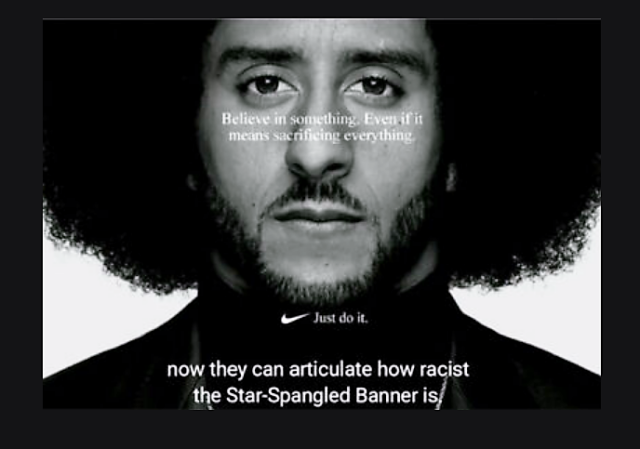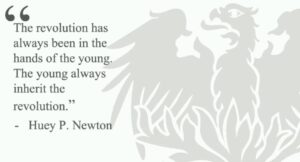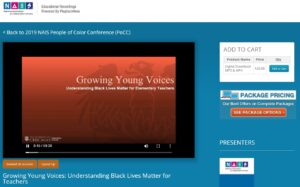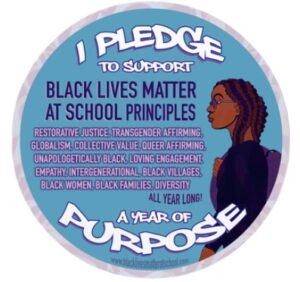VIDEO: Exposing BLM at School—a deep dive into the indoctrination of fourth-graders
University of Chicago Lab School instills BLM’s principles in elementary students, then builds on that foundation to turn them into activists.

As part of my investigation into the National Association of Independent Schools‘ (NAIS) People of Color Conference (PoCC), I watched “Growing Young Voices: Understanding Black Lives Matter for Teachers,” a presentation where two elementary school teachers at the $35,000/yr University of Chicago Lab School detail their implementation of the “Black Lives Matter at School” curriculum.
Referencing seven video clips from that session, I will show how these educators inculcate BLM principles in their fourth- and fifth-grade students, and then build on that foundation to steer them towards activism.
The session is still available for purchase on the NAIS website, but may cause browser security errors, so an archive is also available. (In the past, NAIS has had published clips removed and scrubbed web pages after links to their material were published.)
BLM’s 13 Principles: Laying the Philosophical Foundation
In this first clip, the fourth-grade teacher wants students to “deeply internalize the things that we’re talking about” and for them to use these 13 principles “on a daily basis, as a mirror in their lives.” Her goal is to implant a system of values explicitly tied to their behavior in all domains of life.
She also deploys the oppositional frame that “we want them to understand that decency that they get in school is not mimicked by the society outside of school.” In so doing, she sets up the children to perceive the larger world as inherently unjust and corrupt, compared to the in-school environment where virtue is preserved by BLM norms.
Cults employ a similar “splitting” technique to turn the unsuspecting against the outside world. In Cults and Children: The Abuse of the Young, Arnold Markowitz and David A. Halperin explain that “[splitting] is related to the effort to sever old ties, to split off and isolate affects, which are part of the individuals’ earlier emotional experiences built up through repetitive contacts with significant others.”
The loaded question, “Why do black lives need to matter?” is a shrewd rhetorical manipulation that assumes that children uninstructed in these BLM principles—specifically white children in this instance—are somehow automatically and inherently dismissive of “black lives.” The question is premised on a core tenet of Critical Race Theory, that “racism is ordinary, not aberrational—’normal science,’ the usual way society does business, the common, everyday experience of most people of color in this country.” (Richard Delgado and Jean Stefancic, authors of Critical Race Theory: An Introduction)
Most people, including the young, already functionally understand that “black lives matter”—as a corollary of the a priori dignity of all individuals (i.e. “all lives matter.”) In contrast, this teacher’s formulation of “mattering” introduces an extra weighted significance above and beyond this basic moral proposition. And it implicitly casts anyone questioning the need for the added baggage of these 13 principles as suspect, a potential cretin who may harbor the unspeakable belief that black lives don’t matter.
We all have a deep need to be confident in our own innate goodness, and children in particular need to see that goodness reflected in authority figures’ perceptions of them. Crafty and deceitful messaging like this exploits a child’s foundational need to be seen as a good person. By linking moral worth to their submissive assent, the teacher muzzles doubt and effectively compels adoption of the principles. This is a powerful tactic when used on adults, let alone on a 9-year-old.
The Cultivation of Frailty: “Impact, regardless of Intent”
A major component of “restorative justice” is the maxim “impact over intent”, which subordinates individual rights to those of the group.
The presenter’s analogy exaggerates a minor physical harm (“that foot is still throbbing,”) while dismissing student stoicism or indifference (“oh, they just get their foot off”) as ethically lacking. By doing so, she encourages frailty in children by raising expectations that “restorative justice” is required even in the most trivial disputes.
She also promotes the strawman that, until this point, the children have no consideration of others’ feelings, and that in general, they think the blithe claim “I didn’t mean to,” is sufficient after wronging someone. The implication is that students who don’t employ “restorative justice” are selfish and heartless.
As mentioned earlier, it’s important for children to trust that they are seen as good people. “Impact, regardless of intent” chills expression by placing the burden of tolerance squarely on the speaker, who under this new regime must tailor utterances to how they imagine they will be understood by the most likely to be offended. Additionally, it introduces a moral hazard whereby any member of the group can gain attention and power in a situation by claiming “harm”.
Dr. Lyell Asher explains the significance of the word choice “impact” in “impact not intent”. “Impact” typically describes the interaction of physical objects, whereas “response” is used for the reactions of people. Substituting “response” with “impact” subtracts the reasonable expectation of agency and self-regulation on the part of the person claiming injury. It renders the reaction reflexive so that all responsibility for the perception of harm rebounds upon the initiator.
Grievances will also be seen as more legitimate if they are seen to politically align with the interests of a group already considered to be oppressed or traumatized.
Vocabulary as Priming: “Reparation”
Next, we glimpse how the language of this new moral system will be leveraged for political ends. Students will be primed, having “internalized what a reparation is” before they enter fifth grade, whereupon they will “have a debate on why we need to have reparations for slavery in America.”
But what’s missing here? Students are not warned of any potential pitfalls, unintended consequences, or cost-benefit tradeoffs inherent in considering how the principle is to be applied. As a core component of “restorative justice,” “reparation” is to be internalized as an unquestionable moral good, with no reasonable limits placed on its expectation, delivery, or proportionality. They are simply told that “it has to do with making things better over time.”
Once “reparation” is framed as a moral imperative, it’s difficult to see how any debate held under these circumstances could be even-handed or objective.
“Unapologetically Black”
Considered here to be one of BLM’s most challenging principles, “Unapologetically Black” is described as a stereotypical aesthetic centered on hairstyles, clothing, shoes, and makeup. Somewhat alarmingly, it also implies a callous or oppositional attitude, even when practiced by teachers towards students (“It’s the morning, honey, and I’m not ready for you.”)
Furthermore, any concern that students might wonder if they can be “unapologetically white” (exercising a common instinct for a universal standard) is met with the thought-terminating reprimand: “Honey, your whole existence is unapologetically white…that’s what your life existence is.” In an environment where it’s unclear how non-black students are supposed to manifest “unapologetically black” beyond uncritical allyship, appreciation, and solidarity, and where racial double-standards are celebrated, I don’t think this cursory dismissal will have the intended effect. On the contrary, it seems likely to backfire.
It’s also significant that this teacher has a picture of the rapper Christopher Wallace (aka Biggie Smalls, the Notorious B.I.G.) in a place of honor in her fourth grade classroom. Known for his crude, violent, and sexist lyrics, Smalls was arrested seven times before his murder in 1997. Accomplished and talented though he may have been, what does it communicate to her students that this person is held up as a role model for “unapologetic blackness”?
Lionizing Colin Kaepernick
How can a pedagogical approach can be represented as collaborative and “constructivist“—and yet still result in foregone conclusions?
In a fifth grade exploration of Colin Kaepernick, the teacher first collects students’ initial preconceptions, and then presents a guiding question that focuses on Kaepernick’s own rationale for kneeling. Although students do uncover the more complex backstory involving Kaepernick’s compromise with Nate Boyer, they are led to accept Kaepernick’s motives uncritically, as well as to research using Google (whose algorithm is far from objective, and may favor traditional liberal media outlets simply because they are more numerous). Also, what about the many Americans who continue to feel that Kaepernick kneeling in protest was disrespectful? Why don’t they also get the benefit of “impact, regardless of intent?”
Nor are students encouraged to ask, “How true is it that Kaepernick, possessing of substantial fame and media attention, wasn’t able to express his reservations outside of the two minutes of what many consider a sacred national ritual?” Moreover, while it’s undeniable that some media outlets presented events in a slanted way, to disparage right-wing bias without also acknowledging left-wing bias is to put a lead foot on the scale.
Most importantly, at no point are students urged to engage with the broader question of how to balance a constitutional right to free speech with a business owners’ right to make personnel or public relations decisions, or limit employee expression while on the job. This would reflect an authentic engagement with the Kaepernick story. It would also demonstrate real pedagogical value and promote genuine viewpoint diversity.
Our Racist National Anthem
Now that the cursory and one-sided investigation the Kaepernick story is complete, the teacher turns to an analysis of the national anthem, nut-picking a deprecated third verse that hasn’t been included in the lyrics since World War I.
After superficially parsing the text, the teacher leads his students to conclude that the verse is “celebrating the death” of all slaves, rather than specifically those fighting on the British side during the failed bombardment of Fort McHenry. The teacher also glosses over the fact that both escaped and freed formerly enslaved persons also fought to defend Baltimore harbor. There’s clearly more to this complex history than the teacher wants to get into with his students.
The predictable upshot of this crude analysis is that students conclude that the national anthem is unequivocally racist, and revere Kaepernick even more for “standing up for something bigger then himself”. The presenter then goes on to explain why it’s so important to lay this foundation for political activism:
“I guess I would like to hear one person’s perspective. Because this is exactly what we do with our kids, right? They’re having these discussions just like you all are right now. Right? After we have built a certain foundation. And that foundation is great to build, right? Because now when adults are questioning my kids, like ‘Why are you sitting on your hands when the Star-Spangled Banner, the national anthem is being played?’ They’re able to articulate it on a lot of fronts, right? Not only are we talking about social injustices against Blacks being killed by unarmed police officers [sic], but they can now articulate how racist the Star-Spangled Banner is.”
These newly-minted student-activists now not only have their marching orders, namely sitting on their hands at future sporting events, but they have a doctrinaire justification for their actions—so important for neutralizing troublesome reactions from disturbed parents.
Lastly, we turn to how students manifest this indoctrination in their final projects.
Spoken Word Project – “Gone”
Many have been alarmed by recent cases of young children being turned into activists, and what follows is yet another example.
(Rumble link) (Note: While the original NAIS video includes images of the children performing, we have removed them from this excerpt.)
How curious that, given current educational trends that consider rote learning passé, the students who wrote and presented this project by heart were lauded for memorizing names and dates.
There are many other takeaways here. Lacking is any differentiation among the cases with regard to the facts. Worse is the implication that all these instances exemplify the same brutal racism evident in the horrific murder of Emmett Till, and they also assert the totally unfounded claim that all victims “only got killed because of the color of their skin.” And no mention of statistics showing that twice as many white victims are killed by police than black victims. Are Tony Timpa, Daniel Shaver, Dylan Noble, or Brandon Stanley relevant? What about their names?
Issues of police violence can be engaged with (although fourth grade is probably too early.) But it grossly distorts matters to claim that only members of certain racialized groups are targeted, and entirely for their skin color. This also weaponizes children towards a particular political end. It is unconscionable, even abusive, to exploit children as political pawns in this way.
Black Lives Matter at School is Widespread
The umbrella of organizations known as Black Lives Matter have had a difficult start to the year. Finances of the Black Lives Matter Global Network Foundation remain unaccounted for, and their leadership is in disarray. Fiscally sponsored by opencollective and funded by the NEA, BLM at School held a “Black Lives Matter in School Week of Action” across America during this year’s Black History Month. Their curriculum is widely used nationally in public schools.

An image from the presentation “Growing Young Voices: Understanding Black Lives Matter for Teachers”
It’s unclear how frequently the BLM at School curriculum is used in privates, but teachers at NAIS schools have led the adoption of increasingly radical curricula in recent years, with the support of their administrations. And the playbook for implementing CRT-based DEI in the classroom follows a similar pattern illustrated in the clips above, regardless of whether or not the curriculum is associated with BLM. For example, “impact, regardless of intent” as a moral imperative is common in K-12, not just in BLM at School.
Indoctrination is a Sequence
Effective teacher-indoctrinators don’t immediately jump into political topics with their students. Instead, they prime them in sequence. Starting first from a child’s innate sense of fairness and empathy, they lay down a moral foundation based on group identity and group rights, and follow that up by teaching history and current events in a one-sided manner. Only then have they created minds fertile for activism.
TFW parents realize they're paying $50,000/year so their kids can be taught by Marxists 🤦 #ExposeNAIS https://t.co/WqtQp7cdGO pic.twitter.com/0Xse4Jxhae
— Paul Rossi (@pauldrossi) February 21, 2022
CRT-based lesson plans and curricula are being implemented nationwide by highly motivated, ideologically-driven educators. They are sequencing content across grades in a sophisticated manner, in order to turn children into social justice warriors. I urge all parents to remain vigilant, and investigate how, and what, their children are being taught at their schools. As always, please let me know what you discover, at [email protected].
This is the fourth in a series of articles devoted to exposing the radical influence of the National Association of Independent Schools (NAIS) on the culture and curriculum at their 1,900 member schools, which include some of the most elite K-12 institutions in the country.
—————————
Paul Rossi is a high school mathematics teacher, tutor, and writer. In April 2021, he went public about the impact of Critical Race Theory and pedagogy on his students at Grace Church School, where he had taught since 2012. He is currently an advisor to the Educational Liberty Alliance and a co-host of Chalkboard Heresy (launching soon) Please send tips and stories to [email protected] or DM on Twitter at @pauldrossi.
 DONATE
DONATE
Donations tax deductible
to the full extent allowed by law.










Comments
If Kamala Harris grew an afro….
Have you ever seen a Hindu with an Afro????
… she’d look like Kamala Harris with an Afro?!? Did I guess right?!?
This is Marxist brainwashing writ large
You got to read this at Conservativetreehouse
https://www.weaselzippers.us/479916-secretary-of-state-blinken-suggests-u-s-wont-ban-russian-oil-and-gas-without-europes-permission/
Math is racist, so they can’t add 2 + 2. But don’t fret…they can memorize leftist drivel like nobody’s business.
Apparently the true value of the 3 Rs lies strictly in their usefulness as a tool for indoctrination.
Only white people care about getting the right answer. Which is why, I’m told, Asians are white supremacists.
https://www.npr.org/2021/01/24/960060957/understanding-multiracial-whiteness-and-trump-supporters
Had I known 25 years ago this would have turned out to be the kind of racket that a dumbass like Ibram X. Kendi could milk for $25k giving corporate talks (Lenin was right about capitalists and rope) I would have started it myself.
Gotta go; Gotta go meet a stripper for lunch who is clearly smarter than me. I can’t game the system like she and the race humpers have. She’s an illegal who will be giving me stock tips. I hear Pelosi and family made out like bandits during Covid. What do I mean, like bandits? Pancho f***ing Villa New Mexico 1916. That’s the Kali Democrap party. I would say sorry, America. But I had nothing to do with it.
I woke up this morning and I turned on the bathroom light. There, bright as day, was a spider. The first thing that crossed my mind was at least you’re doing some f***ing good. I shut the light off after doing my business and left her alone.
I would have freaked out if it was Pelosi with the eye brow lift. Thank God it was just a wolf spider.
Totally admire what you are doing. These people are phonies, selling social justice tonic that poisons the human heart, so they can profit.
“Honey, your whole existence is unapologetically white…that’s what your life existence is.”
Yes. Yes, that’s exactly what it is.
And if that bothers you… fuck you.
IT’S OK TO BE WHITE.
Say it loud, crackers: “I’m white and I’m proud.”
The teachers need to be physically run out of town.
100 upticks.
“The teachers need to be physically run out of town.”
Perhaps after an old fashioned tar and feathering experience?
Well, it *is* the *Lab* School, after all.
They’ve probably been teaching different versions of this “internalization” process since the lab’s inception.
They will tell you they don’t teach racism and it’s good that they do. that’s from a real teacher.
“And no mention of statistics showing that twice as many white victims are killed by police than black victims.”
Problem there are more whites than blacks in the US, in other words the rates of white being murdered by police is lower than blacks. The source liked specifically states this.
“The teacher also glosses over the fact that both escaped and freed formerly enslaved persons”
This is pretty dubious history, many slaves were promised freedom only to have that promise rescinded post conflict. The idea that a few slaves fought against the British doesn’t really resolve or deal with any of the issues of contemporaneous issues.
I’m not really into reductionist arguments like CRT but it would be good to get the basic facts right to enable a proper conversation.
If one knows know history in the first instance, there is no such thing as dubious history. The BLM “Black folk”, learn as they go, kind of an “ad hoc” history. The implication seems to be that they have no history, apart from the intertwining with the “White folk.” White folk set off Black folk in so many ways.
On the Latin ( I dont know why folk refer to Latin as ‘the Latin’, German as ‘the German’. ) My question is how essential to Rule of Law is the Latin ‘ex post facto’?
Because when the BLM folks call for ‘restorative’ justice’, I take that to be code for reparations. Slavery was legal, slavery was universal, and if that is fact, why does not the ‘ex post facto’ nullify?
Apparently I know know spelling.
No such thing as dubious history? That’s absolute crap. History from an academic perspective has rigour in that you argue your case taking the totality of evidence from all directions in order to draw a reasonable conclusion. With respect to some of the BLM stuff I’m not overly familiar with the literature, my impression at first glance is that it’s narrative driven from the black perspective which is valid up to a point. Its a kind of social history which has its uses but can be critiqued like any other history – does the narrative stack up?
The question regarding reparations is an interesting one. The reality is that slavery is a moral evil. It’s not really about legality that’s not the frame of reference. The frames terms can be argued and that’s a deep subject in its own right. To put it in context the British did reparations around the time they ended slavery, that cost has only just been paid in the last few decades. That was considered a moral thing to do, and I’m inclined to agree.
With respect to slavery being universal , that might have been true for a period of time but the US engaged in slavery for considerably Conger than many European powers.
If one knows know history in the first instance, there is no such thing as .dubious history
The second response, an unintended thumb tweed.
“No such thing as dubious history?” No such thing as a history, if a-historians can bend our dubious history to their history, the a-historical historians
Fat, I wrote “If.”
So lets talk about blacks killing each other, and about blacks not lifting a hand to change that, and about black rioting and looting.
Blacks have had opportunity on a platter for a long time, most either do not want to do the work, or they just are not smart enough for college.
%here are plenty of white people with the same problem, most go into trades.
I demand to know where they get off culturally appropriating English if they have no English blood. (BTW, my 23&me report says I do).
Do they realize they are teaching kids about an anti-Semitic hate group* whose tax exempt status has been pulled by numerous states due to failure to file required documents, and is on record as promoting or at least excusing looting, rioting, and use of deadly force on police officers? As but one example, they protested when a cop shot Hakim Littleton for pointing a gun at another cop’s head and pulling the trigger. (Luckily for the cop, he was a bad shot.)
* While criticism of Israel’s government is not anti-Semitic, denial of Israel’s right to exist is and Patrisse Cullors called for an end to Israel in her capacity as a BLM leader. Anti-Israel hate has also been chanted at BLM rallies and tolerated by the organizers.
Reading Race Marxism by James Lindsay, he is doing job nailing down where CRT started and what they are believing.
Am I close when I postulate Horkheimer and Markuse?
http://blogs.law.columbia.edu/critique1313/files/2019/09/Horkheimer-Traditional-and-Critical-Theory-2.pdf
Kapernicks mother is WHITE. Do families of black slave OWNERS get reparations?